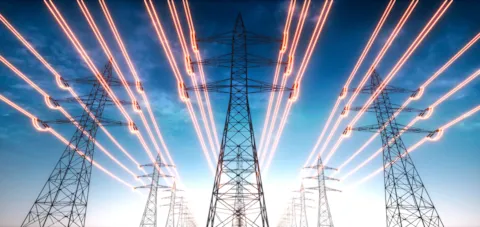DNV launches joint industry project to identify barriers to the use of High Voltage Direct Current transmission in the U.S. grid
DNV launched a joint industry project (JIP) with ten offshore wind and transmission developers to identify changes to electrical standards and standardization needed to enable the connection of High Voltage Direct Current (HVDC) transmission into the United States’ electric grid. HVDC is an essential component for integrating offshore wind, and other sources of clean energy, reliably and cost-effectively onto the power grid over long distances.
Phase one of the JIP will run through early 2024, during which DNV and the JIP participants will undertake an inventory of and prioritize key technical issues that stand in the way of the timely and efficient use of HVDC transmission. After ranking the issues based on the participants’ experiences, the group will identify a stakeholder body most responsible for implementing a solution.
Members of the JIP include:
- Atlantic Shores Offshore Wind
- DNV
- EDF Renewables
- Equinor
- Invenergy
- National Grid Ventures
- Ocean Winds
- PPL TransLink WindGrid
- RWE
- Shell
- TotalEnergies.
This JIP comes at a critical time. Today, HVDC transmission is not widely used within the U.S., and there are appreciable barriers to its further development that represent a serious risk to the long-term development, growth, and economic feasibility of clean energy projects being propelled by the 2022 Inflation Reduction Act. In fact, DNV’s recently published Energy Transition North America report found that the U.S. will not achieve its clean energy goals without modernizing its power grid. Our forecast shows that more than 5,900 miles of HVDC undersea transmission cables are needed to enable efficient offshore wind development by mid-century.
“To put it simply, there will be no transition without transmission,” said Richard S. Barnes, Region President, Energy Systems North America at DNV. “It doesn’t matter how much clean power generation capacity is online if there is no low-cost, reliable way to get that energy to the grid. HVDC transmission is a key part of the solution, and DNV is proud to be working with leading offshore wind and transmission companies to tackle head on the barriers preventing its deployment.”
Upon completion of phase one, DNV and the JIP participants will use the JIP findings to raise awareness of the barriers to the greater use of HVDC transmission and the stakeholder bodies who can help overcome them. Through this effort DNV and the JIP participants hope to reduce project risks, accelerate deployment timelines, and ensure that supply chain constraints are appropriately considered.
DNV has been collaborating with businesses and governments for more than 90 years to ensure affordable, reliable, and sustainable grid operations. In September 2023, DNV was awarded the role of coordinating offshore wind and transmission developers, utilities, regional transmission operators, equipment manufacturers, and other key stakeholders to identify gaps in U.S. HVDC standards. Additionally, DNV coordinated the European Union’s Horizon 2020 PROMOTioN project to research, develop and demonstrate the key technologies and regulatory and economic frameworks essential for accelerating the deployment of meshed HVDC offshore grids.
